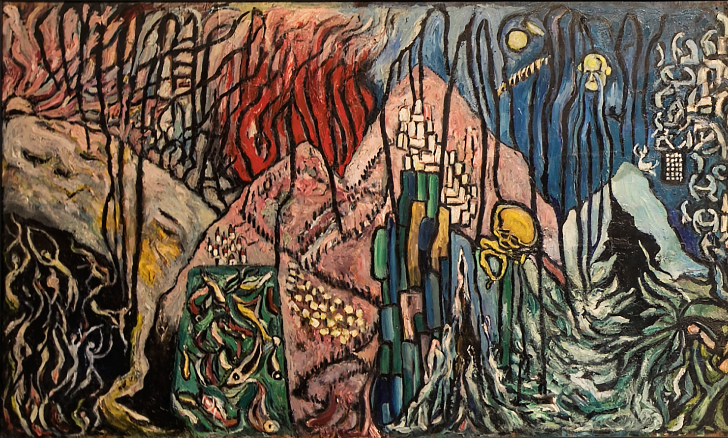Middle East's highest-selling painter: Who is Fahrelnissa Zeid?
Although her family calls her Fahrünnisa, she prefers to use her name as Fahrelnissa abroad and in the signature of her paintings. Queen Elizabeth of England attends the opening of her exhibition in 1947.

It is also known that Adolf Hitler praised Zeid's paintings. There are paintings bearing her signature in a few museums of the world.
Painter Fahrelnissa Zeid, born on January 7, 1901, in Büyükada, Istanbul, is from the Kabaağaçlı family, which has trained many artists. She is the sister of Halicarnassus fisherman Cevat Şakir and painter Aliye Berger, mother of actress Şirin Devrim and painter Nejad Devrim, and aunt of Turkey's first female ceramic artist Füreya Koral.
Her family has a military background. Since her grandfather, Miralay Mustafa Asım Bey settled in the village of Kabaağaçlı in Afyon and owned a farm there, the family took the surname Kabaağaçlı. One of his sons, Cevat Pasha, is the grand vizier of Abdulhamit, and his other son Shakir Pasha is a diplomat as well as a soldier, and he represents the Ottoman Empire abroad twice as an ambassador.
Fahrelnissa Zeid (7 January 1901 – 5 September 1991) was a Turkish artist best known for her large-scale abstract paintings with kaleidoscopic patterns as well as her drawings, lithographs, and sculptures. Zeid was one of the first women to go to art school in Istanbul. She lived in different cities and became part of the avant-garde scenes in 1940s Istanbul, and post-war Paris.
The writer Cevat Şakir Kabaağaçlı, known as the Fisherman of Halicarnassus, and the painter Aliye Berger are the siblings of Fahrelnissa Zeid. Nejad Devrim, who is also a painter, is her son, theater actor Shirin Devrim is her daughter, and ceramic artist Füreya Koral and painter Cem Kabaağaçlı are her nephews.
Although her family calls her Fahrünnisa, she prefers to use her name as Fahrelnissa abroad and in the signature of her paintings. It is known that her interest in painting started at a young age. This interest, which started at the age of 9-10, enabled her to draw patterns like mature painters at the age of 14.
Her work has been exhibited at various institutions in Paris, New York, and London, including the Institute of Contemporary Art in 1954. In the 1970s, she moved to Amman, Jordan, where she established an art school. In 2017, Tate Modern in London organised a major retrospective and called her "one of the greatest female artists of the 20th century".
Fahrelnissa Zeid begins her painting education at the Ottoman Empire's women-only art university in 1919. Due to the overlapping difficulties, she interrupted her education and got married. From this marriage, which lasted 14 years, painter Nejad Devrim (1923 - 1995) and theater actor Shirin Devrim (1926 - 2011) were born.
In 1928, she goes to Paris with her husband. She follows painting classes at the Académie Ranson and the Roger Bissière workshop. She returns to Istanbul and continues her workshops at the art university in Istanbul between 1929 and 1930.
Her largest work to be sold at auction, Towards a Sky (1953), went for just under one million pounds in 2017. Her record is the USD 2,741,000 sale of her Break of the Atom and Vegetal Life (1962) in 2013 by Christies.
This period itself is a highly admired and popular name in certain circles for its beauty and culture. It is known that she acted as a jury in beauty contests of that period and played in a French theater play written by the wife of Clerk, the British ambassador to Turkey. She is one of the sought-after names in the art circles of the period.
Fahrelnissa Zeid separated from her husband in 1933 and married Prince Zeid bin Hussein, the Iraqi ambassador to Turkey, brother of King of Iraq First Faisal, in 1934. In addition to Berlin, where her husband was an embassy, she lived in Baghdad for a while when her husband was the regent. Her son Ra'ad Bin Zeid was born in Berlin in 1936.
In 1941, she decides to return to Istanbul and exist in the art scene. Fahrelnissa Zeid joins Group D and her exhibitions in 1942. She held her first personal exhibition at her home in 1944. The 1940s were the years when Fahrelnissa Zeid developed her own unique style that blended European painting traditions with Eastern cultural themes.
The late 1940s were the years when she started to focus on abstract compositions, which are now her best-known works. These are works that are extremely monumental and contain intense lyricism, in which luminous colors are used.
Between 1950 and 1960, Fahrelnissa Zeid also achieved an abstract reminiscent of the romantic wing of American abstract expressionism. Rather than pictorial details, the desire to make the material read itself comes to the fore, the subject lags behind this texturing and painting.
With the sale of one of her paintings in 2013, Zeid wins the title of a female artist depicting the highest-selling work in the Middle East. In this painting, Zeid blended the aesthetics of Islamic calligraphy and the mystical characters of Sufism with the aesthetics of Byzantine and Western art, which she was influenced by during her years in Paris.
She opens 4 exhibitions in London and 6 exhibitions in Paris, and Queen Elizabeth of England attends the opening of her exhibition in London in 1947. It is also known that Adolf Hitler praised Zeid's paintings. Apart from that, her works are exhibited in Amman, the United States, Switzerland, and Belgium. There are paintings bearing her signature in a few museums of the world.
After the death of her husband, Fahrelnissa Zeid goes to Jordan, where her son is working and begins to live in the city of Amman. The artist continued to live here until her death in 1991. Upon Zeid's death, the king of Jordan declares national mourning in her country. Princess Fahrelnissa Zeid is buried in the Royal Jordanian Cemetery.
